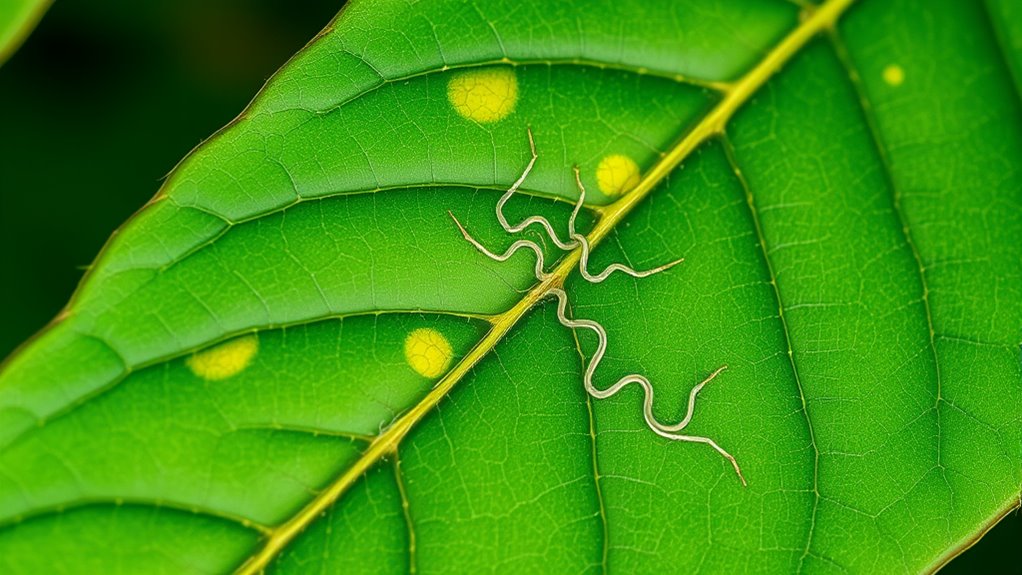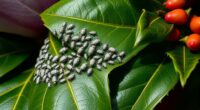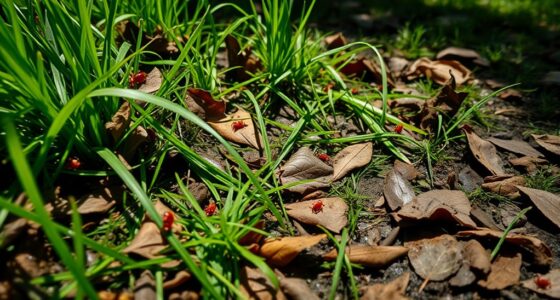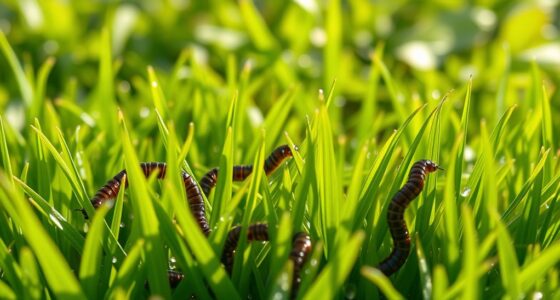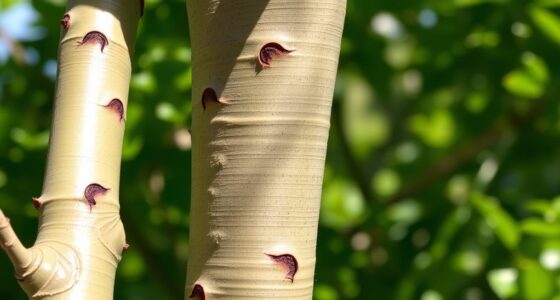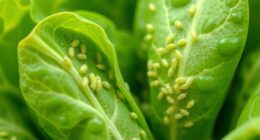To spot boxwood leafminer, watch for early signs like leaf discoloration, distortion, and silvery trails, often appearing in late spring or early summer. The larvae hatch during this time, making it essential to act promptly—removing infested leaves or pruning to control the pests early on. Chemical and biological controls work best post-hatch, so understanding their timing helps you manage the infestation effectively. Keep going to find out how to keep your boxwoods healthy and pest-free.
Key Takeaways
- Look for early signs like silvery trails, distorted leaves, and yellowing in late spring or early summer.
- Larvae hatch in late spring/early summer, initiating feeding inside leaves.
- Remove heavily infested leaves early to prevent further damage.
- Biological controls are most effective when applied soon after egg hatch.
- Timely cultural practices, such as pruning and maintaining plant health, help minimize infestation impacts.
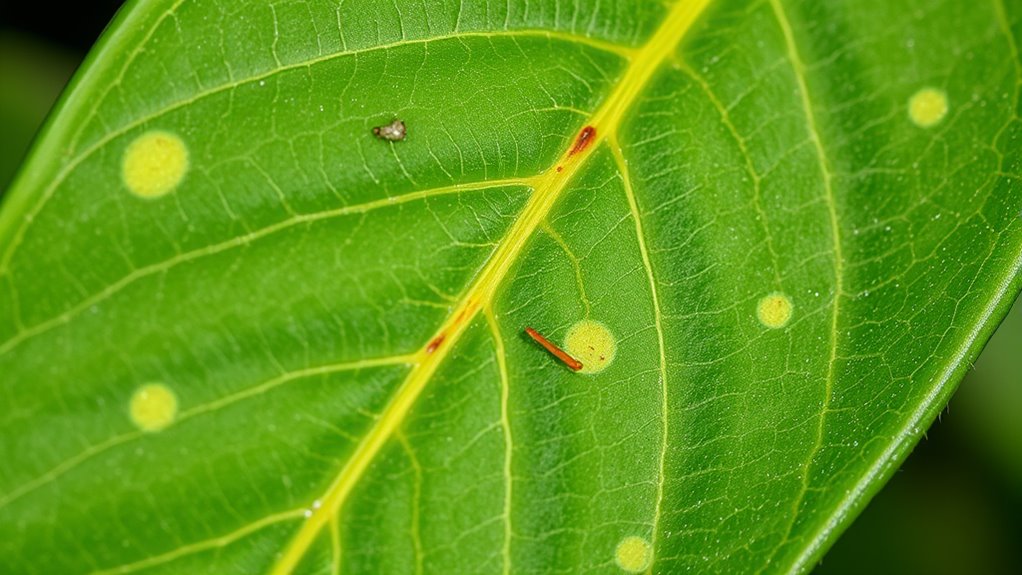
The boxwood leafminer is a tiny insect that can cause significant damage to your boxwood plants. It’s easy to overlook at first since the symptoms often appear as subtle yellowing or browning on the leaves, but if left unchecked, the infestation can weaken your plants and diminish their aesthetic appeal. Recognizing early signs is pivotal to managing the problem effectively. One of the most effective approaches to controlling leafminers is through cultural control methods. This includes proper pruning to remove infested or damaged leaves, which helps reduce the number of larvae and pupae hiding within the foliage. Additionally, maintaining healthy plants through adequate watering and fertilization can boost their natural defenses, making them less susceptible to infestation. Avoiding excessive watering or over-fertilization is key, since stressed plants are more attractive to pests.
Biological agents also play an essential role in managing boxwood leafminers. These natural enemies, such as parasitic wasps, target leafminer larvae and pupae, helping to keep their populations in check without the need for chemical pesticides. Introducing or encouraging populations of these beneficial insects can be a sustainable and environmentally friendly way to control the pest. You can sometimes purchase commercially available biological agents, which are specifically formulated to combat leafminers, and release them around your boxwoods. This approach not only reduces chemical use but also helps establish a more balanced ecosystem in your garden.
Timing is critical when it comes to managing leafminers. The first signs often appear in late spring or early summer, when larvae hatch and begin feeding inside the leaves. If you notice the initial leaf distortion or silvery trails on the foliage, it’s best to act promptly. Applying biological agents during this early stage maximizes their effectiveness, as they target the larvae before they mature and cause more extensive damage. Cultural control measures, like removing and destroying heavily infested leaves, should also be performed during this period to minimize the spread. If you decide to use insecticides, timing them to coincide with the larval stage—just after egg hatch—is most effective, but always consider integrating biological control to minimize environmental impact.
Frequently Asked Questions
How Can I Prevent Boxwood Leafminer Infestations?
To prevent boxwood leafminer infestations, you should adopt cultural practices like regularly inspecting your boxwoods and removing affected leaves. Use biological control by introducing beneficial insects such as parasitic wasps that target leafminers. Additionally, avoid over-fertilizing, which can encourage pests. Properly maintaining your plants and early detection help keep infestations at bay, ensuring your boxwoods stay healthy and vibrant throughout the season.
Are There Natural Predators for Boxwood Leafminers?
Did you know that natural predators can reduce boxwood leafminer populations by up to 60%? You should consider biological control methods, as natural predators like parasitic wasps are effective against leafminers. These beneficial insects target the larvae, helping manage infestations naturally. Incorporating natural predators into your pest control strategy not only minimizes chemical use but also promotes a healthier, balanced garden ecosystem.
What Are the Long-Term Effects of Infestation on Boxwood Health?
If you ignore a leafminer infestation, it can weaken your boxwood’s resilience and harm its long-term plant health. Repeated or severe damage may cause leaf drop, branch dieback, and overall stress, making the plant more vulnerable to diseases. Over time, the boxwood may become less vigorous, lose its aesthetic appeal, and struggle to recover. Regular monitoring and prompt treatment help safeguard your plant’s resilience and ensure its long-term health.
Can Boxwood Leafminers Affect Other Plant Species Nearby?
Think of boxwood leafminers as a sneaky neighbor who spreads trouble beyond their yard. While they primarily target boxwoods, they can have a cross species impact, affecting nearby plants. I saw a garden where infested boxwoods seemed to weaken, and neighboring plants showed stress too. Although leafminers prefer boxwoods, close proximity can sometimes lead to indirect effects on neighboring plants, especially if pests or their natural enemies move around.
What Are the Best Organic Treatments for Leafminer Control?
You can control leafminers organically by using organic sprays like neem oil or insecticidal soap, which target the pests without harming beneficial insects. Incorporate companion planting with herbs like basil or marigolds to repel leafminers naturally. Regularly inspect your plants and remove infested leaves. These eco-friendly methods will help protect your boxwoods while promoting a healthy garden environment.
Conclusion
If you spot the telltale signs of boxwood leafminer, don’t wait to act. Imagine a gardener noticing early leaf curling, only to see their beloved shrub become heavily damaged if ignored. By recognizing symptoms early and applying treatment promptly, you can save your boxwood from irreversible harm. Stay vigilant this season—your proactive steps can make all the difference in keeping your landscape healthy and beautiful for years to come.
